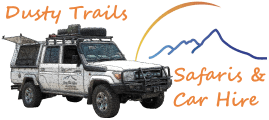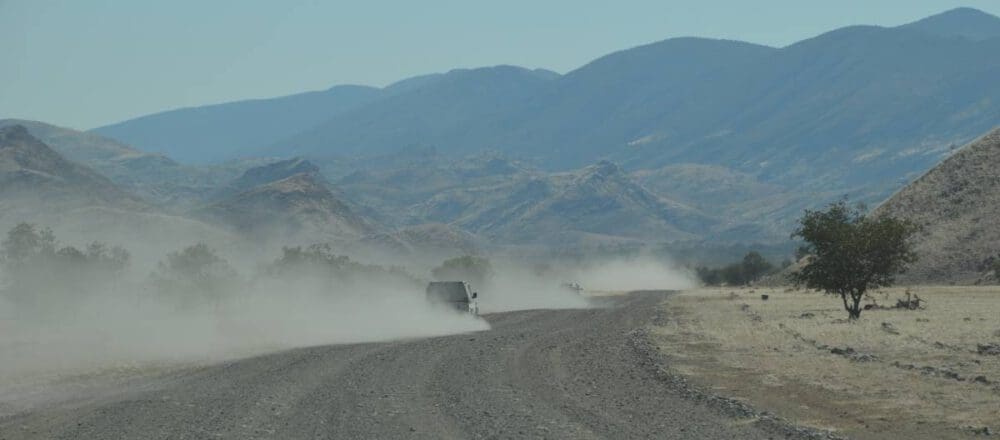Why an article on the subject of safe driving in Namibia may be some questions. The answer is already derived from the pure facts about this country. Namibia has a total area of 824 km² with a population of about 2.3 million people and therefore 2.82 km² per inhabitant. Of course, there is a correspondingly large road network of about 45,000 km to cross this enormous area. However, only about 40% of these are paved roads and the rest are gravel roads or even easier paths. It is not uncommon for larger towns to be 200km apart. In addition, there are extremely extensive desert, mountain and bush landscapes as well as the famous variety of free-living wild animals but also farm animals.
This combination ensures that drivers have to be always alert and the cars are kept in top condition. Otherwise, you risk dangerous accidents where, depending on the area, help may not arrive until 12 hours later. Nobody wants to experience such a scenario, especially not if you are on a self-drive safari. Neither you as a traveler nor we as an organizer. And therefore an article that informs you about the basic rules for safe driving in Namibia makes sense.
General traffic rules the cornerstone for safe driving in Namibia
The challenge of left-hand traffic
First things first – the driver sits on the right! In Namibia, as in all countries of southern Africa, there is left-hand traffic. You will have to get used to this, unless your home country also has left-hand traffic. It can take several days to get used to this. Please take the necessary time for this, drive especially attentive and remember the traffic rules consciously. Even after many years of Namibia travel and driving experience, you will still need time to adjust. You are also guaranteed to use the windshield wiper several times within the first hour with your rental car instead of blinking. Also finding the right gears and estimating the vehicle size is difficult for many in the first hours.
The most important traffic rules
You don’t need to be afraid of city traffic. Here, you usually get into the flow quickly through other road users and the regular look to the left is well memorized. At larger intersections, traffic lights regulate the traffic. At smaller junctions you will usually find stop intersections. The rule for stop intersections is simple but important – the vehicle that reaches the intersection first is allowed to drive. Since anyone can have the right of way, it is advisable to approach carefully and be prepared to stop. At unmarked intersections, left is priority over right.
As soon as you leave the urban area, the real challenge of driving on the left often begins. There is often little traffic on the roads, so you may not see another vehicle for long periods of time. This is where habit creeps in and you unconsciously change sides of the road. If another road user comes to meet you, it can quickly become dangerous.
Quick-Hint
Take some time at the beginning of each day to make yourself aware of the left-hand traffic before you set off.

Driving in Namibia: Seat belt use and speed limits
In principle, seat belts are compulsory on all roads in Namibia. In order to enforce this consistently, you will come across fixed or mobile police checkpoints again and again. As a rule, you will have to stop there and will be checked in detail and asked about your route. In this context, the officers will check your papers as well as the compliance with the seat belt obligation. If you are traveling with children between 3-14 years or under 1.50m tall, they must be provided with a child seat in the car. There is no obligation to use dipped headlights during the day, but it is strongly recommended for better visibility, especially on dusty gravel roads.
Quick-Hint
Buckle up and turn on your headlights before starting your drive
Regulations for speed limits are simple and easy to remember. Within built-up areas, the limit is 60 km/h. Out of town on tarred roads 120 km/h and on gravel roads 80 km/h. In general, the respective regulations and their exceptions are indicated by signs. In general, the limits should not be exceeded. Especially on gravel roads you should rather drive slower than you feel comfortable with, because the condition of the road can change rapidly (soft sand passages, washboards, potholes) and therefore fast driving can occur.
For national parks or game parks there is usually a speed limit of 60 km/h, which you should also adhere to scrupulously, since wild animals can appear at the roadside or pass the road at any time.
What do the street names mean?
A look at the map shows street names preceded by a letter. These stand for the different categories of streets. The order here is alphabetical, with a few exceptions. You can remember a simple formula: the further forward in the alphabet the better the road. Roads and main roads should have at least 2 lanes. Secondary roads can also be single-lane. The exact breakdown can be found in the following list.
- A = Highway
- B = Tar road
- C = Tar road or well-maintained gravel road
- D-F or no letter at all = Gravel road, sand road or other secondary roads
Quick-Hint
Consciously consider the road category when planning your route. On A,B,C roads, daily distances of 200 km can be covered without any problems. On secondary roads, the average speed can vary drastically due to the nature of the road.
Safe driving in national parks

Driving in national parks presents special challenges. You can quickly become distracted due to the spectacular scenery or wildlife discovered, however safety is the first priority here as well. Keep in mind that other visitors may also be distracted. Most importantly, wildlife density is highest there. There may be an animal or even a whole herd behind every bush, startling you and crossing the road in front of you at lightning speed. In these cases, any animal is highly dangerous!
Also during photo stops, e.g. at water holes, you should always keep your eyes open and never block the animals’ way or drive too close to them. If you are standing in the escape route of an elephant, it will simply climb over you and your vehicle if it feels threatened. In most parks, leaving the vehicle is only allowed in certain protected places, as the parks are also home to a corresponding number of predators. Here the rule is: the predator always sees you first and is faster than you think. So don’t risk your life just to take an extra special photo.
If you do have a wildlife accident inside a park, remember two important points:
- Do not leave your vehicle
- Report the accident to the rangers. They will record the incident and help you
Is driving in Namibia more dangerous than elsewhere?
The short answer is – no, it just presents different challenges than you are usually used to. In the vast majority of countries, traffic density and the behavior of road users are the biggest challenges in everyday road traffic. In Namibia and Botswana, the forces of nature and their impact on traffic pose the greatest risk. Therefore, it is important to get used to the new challenges. The best way to do this is to become aware of your surroundings and the basic rules of driving every day.



